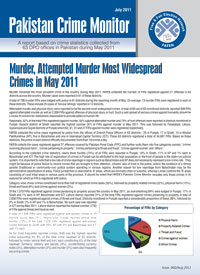Murder remained the most prevalent crime in the country during May 2011. FAFEN collected the number of FIRs registered against 27 offences in 63 districts across the country. Murder cases were reported in 61 of these districts. A total of 790 murder FIRs were lodged with police in 61 districts during the reporting month of May. On average, 13 murder FIRs were registered in each of these districts. These include 25 cases of ‘honour killings’ reported in 12 districts. Attempted murder and physical injury were reported to be the second most widespread crimes.
A total of 60 out of 63 monitored districts reported 949 FIRs against attempted murder as well as 2,056 FIRs against offences of physical injury or hurt. Such a vast spread of serious crimes against humanity should be a cause of concern for institutions responsible to provide safety to human life. Regionally, 52% of the total FIRs registered against murder, 55% against attempted murder and 78% of hurt offences were reported in districts monitored in Punjab. Karachi district of Sindh reported the highest number (67) of FIRs against murder in May 2011. This was followed by Faisalabad, Lahore, Gujranwala and Gujrat districts of Punjab where 62, 61, 31 and 27 FIRs against murder were registered respectively.
FAFEN collected the crime cases registered by police from the offices of District Police Officers in 63 districts – 25 in Punjab, 17 in Sindh, 15 in Khyber Pakhtunkhwa (KP), five in Balochistan and one in Islamabad Capital Territory (ICT). These 63 districts registered a total of 34,607 FIRs. Based on these statistics, the police in each district officially documented more than 18 crimes a day. According to the collected crime statistics, nearly three fourths (74%) of all FIRs were reported in Punjab, 14% in Sindh, 11% in KP and 1% each in Balochistan and ICT.
The high rate of registration of crimes in Punjab can be attributed to the high population or the trust of people in the state-run judicial system. It is important to note that a low rate of crime reportage in regions such as Balochistan and KP does not necessarily represent a low crime rate. They might be because of police failure to record crimes that are brought to their attention, citizens’ lack of trust in the police, and/or the existence of a strong parallel (traditional or community-run) justice system operating in various regions. Another reason for low reportage from Balochistan may be the administrative classification of areas. Police jurisdiction is restricted to ‘A’ areas, which are normally cities or suburbs, whereas Levies controls the ‘B’ areas consisting of rural tribal areas in various parts of the province. It should be noted that FAFEN’s Pakistan Crime Monitor includes only those crimes in its analysis for which an FIR is registered with police. Category wise, minor crimes constituted more than half of registered crime cases (55%), followed by property related crimes (22%), physical harm (12%), threat and fraud (8%) and crimes against women (3%).


